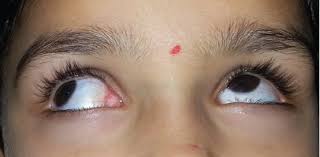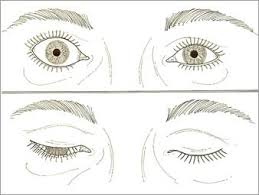What Is Eyelid Retraction?

Eyelid retraction occurs when the upper eyelid remains at an abnormally high level over the eye or the lower eyelid rests at a particularly low position. This is most noticeable by the exposure of sclera (white part of the eye) above or below the iris (colored part of the eye). Normal open eyelid positions lay at the top and bottom edges of the iris. When the eyelid retracts, this often causes the eye to appear at an open position that looks exaggerated and unnatural. Depending on the extent of an individual’s condition, they may develop chronic symptoms from overexposure of the eyeball.
What Are the Symptoms of Eyelid Retraction?
When the upper and/or lower eyelid is retracted, this can cause a variety of symptoms related to the excessive exposure of the eye. The most common issues people experience as a result of their eyelid retraction include the following:

- Exposed sclera above or below the iris
- Unnaturally round eye appearance
- Dry eye syndrome
- Excessive tearing
- Redness
- Burning sensation
- Impaired vision
What Causes Eyelid Retraction?
Eyelid retraction most often develops over time but can be a congenital disorder. The condition is most prevalent in those with thyroid disease (also known as Graves’ disease), especially when it only affects one eye (unilateral). Retracted eyelids can also be caused by multiple other factors, such as trauma, genetics, tumors, following a stroke, and blepharoptosis of the opposite eye. The most prevalent cause of upper eyelid retraction is thyroid disease, while lower eyelid retraction most commonly results from complications from lower blepharoplasty.
What Are the Treatments for Eyelid Retraction?
Treatment for eyelid retraction usually begins with conservative methods of symptom management, such as the regular use of eye drops. Non-surgical solutions like BOTOX® injections are also frequently used to help reduce the amount of retraction present. BOTOX® is especially common for helping those suffering from eyelid retraction due to thyroid disease. Over time, oculoplastic surgery typically becomes necessary since symptoms like dry eye tend to progress.
What Can I Expect During Eyelid Retraction Surgery?
For upper eyelid retraction, surgery involves detaching the levator
muscle, which is responsible for elevating the upper eyelid. This causes
the upper eyelid to naturally rest at a lower position. Surgery for
lower eyelid retraction, on the other hand, varies according to each
case. This may entail the placement of a graft, a midface lift to raise
the bottom eyelid, or tightening of the outer eye corner (canthoplasty).
The goal of eyelid retraction surgery is to reduce the abnormally
round-appearing eyes, revealing less of the sclera above or beneath the
iris. This helps provide long-term relief from chronic symptoms that can
cause irritation and blurry vision. It can also help reduce evaporative
loss which often leads to dry eye.
The most appropriate treatment for a patient’s condition will be
determined once one of our experienced eye surgeons has had the
opportunity to review their medical history, perform a physical
examination, and complete any further testing. For more details about
eyelid retraction, contact Eye Doctors of Washington to schedule an
appointment.